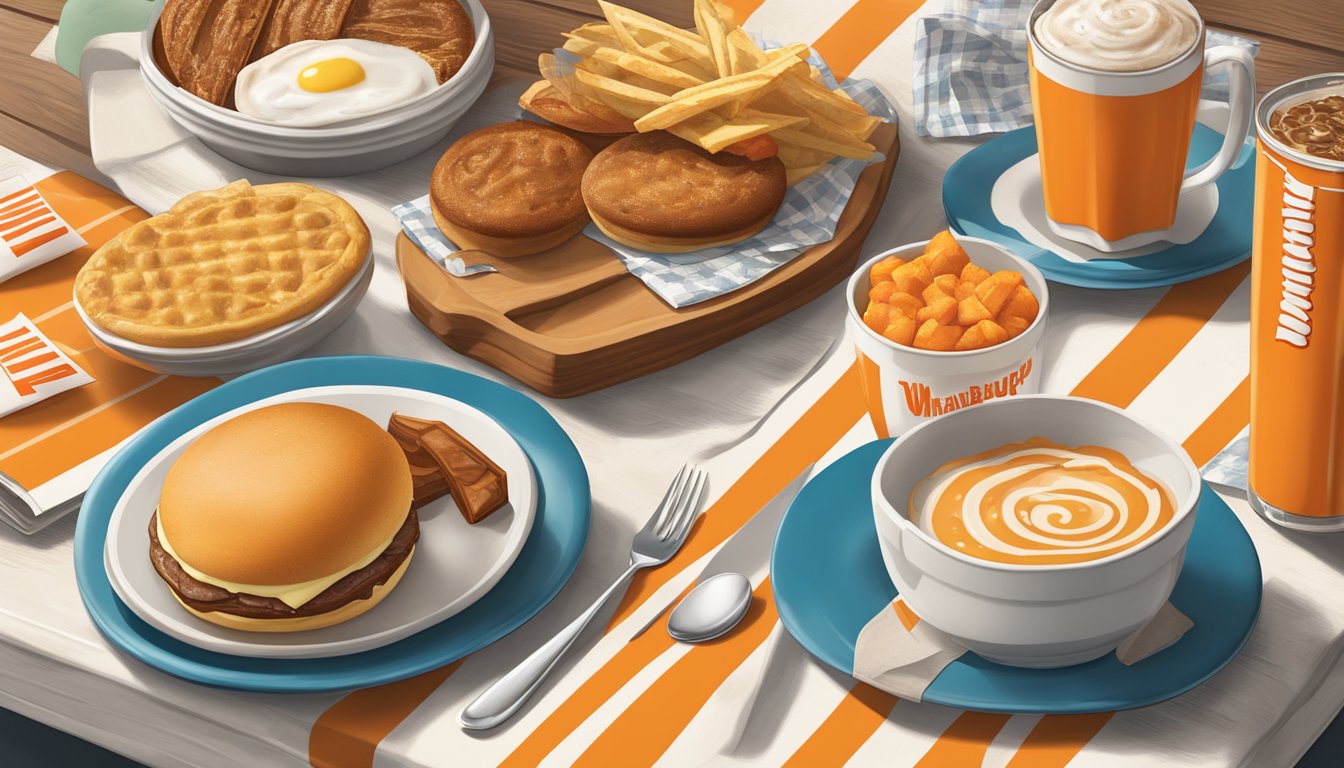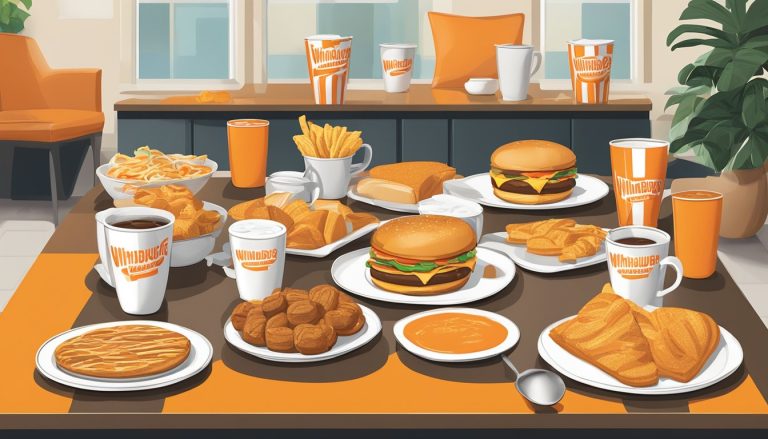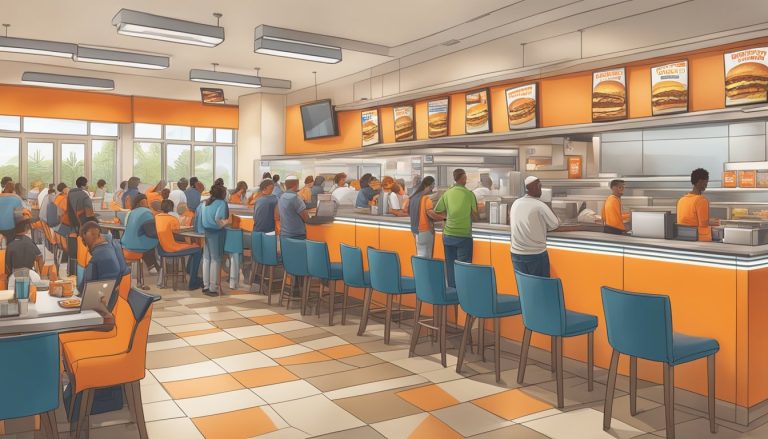Whataburger’s journey from a single burger stand to a beloved Southern icon has been marked by continuous menu evolution. Since its founding in 1950, the Texas-based chain has expanded its offerings to cater to changing tastes and customer preferences. Breakfast items became a significant part of Whataburger’s menu, with the introduction of morning favorites like pancakes, biscuits, and hash browns.
The company’s commitment to quality and innovation has shaped its breakfast menu over the decades. Whataburger’s 24-hour service allowed patrons to enjoy breakfast at any time, setting it apart from competitors. The addition of unique flavors, such as sweet and spicy bacon, brought new dimensions to classic breakfast dishes.
As Whataburger celebrates its 75th anniversary in 2025, the company continues to honor its roots while embracing new trends. The breakfast menu remains a cornerstone of Whataburger’s success, reflecting both its Texas heritage and its ability to adapt to modern tastes.
The Origins of Whataburger

Whataburger’s journey began in 1950 as a small burger stand in Corpus Christi, Texas. The vision of founder Harmon Dobson shaped the company’s commitment to quality and innovation, setting the stage for its growth into a beloved Texas institution.
Establishment in Corpus Christi
Whataburger opened its doors on August 8, 1950, in Corpus Christi. Harmon Dobson and Paul Burton launched the first Whataburger stand on Ayers Street. The modest establishment quickly gained popularity among locals. Its unique offering – a quarter-pound burger so big it required two hands to hold – set it apart from competitors.
The original stand was a simple portable metal building. It had no dining room, only a walk-up window for customers to place their orders. Despite its humble beginnings, the stand’s success laid the foundation for Whataburger’s future expansion.
Harmon Dobson’s Vision
Harmon Dobson, a visionary entrepreneur, aimed to create a burger so big that customers would exclaim “What a burger!” upon seeing it. His focus on quality and size differentiated Whataburger from other fast-food chains of the era.
Dobson believed in using 100% pure beef patties and fresh ingredients. He insisted on made-to-order burgers, allowing customers to customize their meals. This commitment to quality and customer satisfaction became a cornerstone of Whataburger’s philosophy.
His innovative approach extended beyond the food. Dobson designed the iconic A-frame buildings that became synonymous with Whataburger locations, making them easily recognizable across Texas.
Early Menu Offerings
Whataburger’s initial menu was simple yet revolutionary for its time. The star was the namesake Whataburger – a quarter-pound all-beef patty on a 5-inch bun, priced at 35 cents. Customers could add lettuce, tomatoes, pickles, and onions at no extra charge.
The menu soon expanded to include French fries and drinks. In 1957, Whataburger introduced its first side item – “Fancy Fries” topped with cheese. Hot pies became a popular dessert option in the 1960s.
Whataburger’s early success was built on these core offerings. The company maintained its focus on burgers while gradually introducing new items to meet customer demands. This balance of tradition and innovation would guide Whataburger’s menu evolution in the decades to come.
Expansion and Growth

Whataburger’s journey from a single burger stand to a regional fast-food powerhouse is marked by strategic expansion and steady growth. The company’s development spans several decades and geographic regions.
Beyond Texas Borders
Whataburger’s expansion beyond Texas began in the 1960s. The company opened its first out-of-state location in Pensacola, Florida in 1961. This move marked the beginning of Whataburger’s spread across the Southern United States.
By the 1970s, Whataburger had established a presence in Arizona and New Mexico. The company’s growth continued into neighboring states like Oklahoma, Arkansas, and Louisiana.
In recent years, Whataburger has ventured into new territories. The chain opened locations in Alabama, Georgia, and Mississippi. In 2021, Whataburger began its expansion into the Midwest, opening restaurants in Kansas and Missouri.
The A-Frame Era
In the 1960s, Whataburger introduced its iconic A-frame design. These distinctive orange and white striped buildings became synonymous with the brand.
The A-frame structures featured steep roofs that nearly touched the ground. This unique architecture made Whataburger restaurants easily recognizable from a distance.
Many of these A-frame buildings included drive-through windows, catering to the growing car culture of the era. This design helped Whataburger expand rapidly, as the buildings were relatively quick and cost-effective to construct.
Strategic Partnerships
In 2019, Whataburger entered a new phase of growth when the Dobson family sold their majority stake to BDT Capital Partners. This partnership aimed to accelerate Whataburger’s expansion plans.
Under BDT’s ownership, Whataburger has pursued aggressive growth strategies. The company has invested in modernizing existing restaurants and opening new locations.
Whataburger has also explored partnerships with other brands and expanded its product offerings in retail stores. These moves have helped the company reach new customers and markets beyond its traditional restaurant footprint.
The Breakfast Revolution

Whataburger’s venture into breakfast offerings marked a significant shift in the company’s history. The introduction of morning meals expanded their appeal and operating hours, solidifying their place in Southern fast food culture.
Breakfast Menu Introduction
Whataburger launched its breakfast menu in 1979, nearly three decades after the company’s founding in Corpus Christi, Texas. This move aimed to capture the growing market for quick and convenient morning meals. The initial menu featured classic items like biscuits and gravy, pancakes, and scrambled eggs.
Whataburger set itself apart by offering breakfast from 11 p.m. to 11 a.m., catering to both night owls and early risers. This extended timeframe gave them an edge over competitors who typically started breakfast service after 6 a.m.
Breakfast on a Bun
The Breakfast on a Bun became a cornerstone of Whataburger’s morning offerings. This portable meal combined a choice of sausage, bacon, or ham with a fresh egg and cheese on a toasted bun. It quickly gained popularity among customers seeking a hearty, handheld breakfast option.
Whataburger enhanced the Breakfast on a Bun over time, introducing variations like the Jalapeno Cheddar Biscuit version. These adaptations helped keep the menu fresh and appealing to diverse tastes.
Taquitos and Beyond
Whataburger expanded its breakfast menu with the introduction of taquitos, embracing Texan and Mexican culinary influences. These flour tortillas filled with eggs, cheese, and a choice of meat became instant favorites.
The chain continued to innovate, adding items like the Honey Butter Chicken Biscuit and breakfast platters. These additions provided more substantial options for customers seeking a sit-down meal experience.
Whataburger’s breakfast menu grew to include sides like hash browns and a variety of breakfast sauces, allowing customers to customize their meals. The ongoing evolution of their breakfast offerings has helped Whataburger maintain its competitive edge in the fast food breakfast market.
Evolution of Whataburger’s Breakfast Offerings
Whataburger’s breakfast menu has undergone significant changes since its introduction in 1979. The company’s commitment to innovation and meeting customer demands has shaped its morning offerings over the years.
90s Expansion
In the 1990s, Whataburger expanded its breakfast menu to cater to diverse tastes. The iconic Breakfast on a Bun became a staple, offering a hearty start to the day. Taquitos, filled with various ingredients, were introduced to appeal to Tex-Mex food lovers.
The chain also began experimenting with limited-time offers to keep the menu fresh and exciting. These special items often featured regional flavors, reinforcing Whataburger’s connection to its Southern roots.
By the late 90s, many locations extended their breakfast hours to meet growing demand. This move set the stage for 24/7 breakfast service at select restaurants.
New Millennium Innovations
The 2000s saw Whataburger embracing healthier options and premium ingredients. Whole wheat buns and egg white substitutions were added to the menu, catering to health-conscious customers.
In 2005, Whataburger introduced the Breakfast Platter, featuring scrambled eggs, bacon, and a biscuit. This hearty option quickly became popular among those seeking a more substantial morning meal.
The chain also focused on improving coffee offerings, recognizing its importance to the breakfast experience. A partnership with a Texas-based roaster ensured a high-quality brew that complemented the food menu.
Community and Cultural Impact
Whataburger’s breakfast has become deeply ingrained in Southern culture. In many Texas communities, starting the day with a Whataburger breakfast is a cherished tradition.
The company’s dedication to serving breakfast 24/7 at many locations has made it a go-to spot for night shift workers and early risers alike. This availability has solidified Whataburger’s place as a reliable breakfast option.
National Whataburger Day, celebrated annually, often features special breakfast promotions. These events have helped create a sense of community among fans and reinforced the brand’s cultural significance in the Southern United States.
Brand Identity and Customer Experience

Whataburger’s brand identity and customer experience are deeply intertwined, creating a distinctive fast-food experience that resonates with its loyal patrons. The company’s commitment to quality and personalization has shaped its image over the decades.
Iconic Architecture
Whataburger’s orange-and-white striped A-frame buildings have become a recognizable symbol of the brand. These distinctive structures, introduced in the 1960s, stand out in the landscape and serve as beacons for hungry customers. The A-frame design not only provides a unique visual identity but also offers practical benefits for drive-through operations.
In recent years, Whataburger has modernized its restaurant designs while maintaining elements of its iconic look. The updated buildings incorporate energy-efficient features and improved drive-thru layouts to enhance customer convenience.
Menu Customization
Customization is a cornerstone of Whataburger’s customer experience. The brand prides itself on offering numerous ways for customers to personalize their burgers and other menu items. This flexibility allows patrons to create meals that suit their specific tastes and dietary preferences.
Whataburger’s “Just Like You Like It” slogan emphasizes this commitment to customization. Customers can add or remove toppings, choose different bun options, and even request specific cooking methods for their burgers. This level of personalization extends to other menu items as well, including breakfast offerings.
The brand’s focus on quality ingredients further enhances the customization experience. Fresh produce, premium meats, and made-to-order preparation ensure that each customized meal meets Whataburger’s standards for taste and quality.
Contemporary and Future Endeavors

Whataburger continues to innovate its breakfast menu while honoring its Texas roots. The chain has introduced new items and adapted to changing consumer preferences, all while maintaining its reputation for quality and value.
Modern Menu Developments
Whataburger’s breakfast menu has evolved to include healthier options alongside its classic offerings. The chain introduced the Breakfast Bowl in 2023, featuring scrambled eggs, potato chunks, and a choice of bacon or sausage. In 2024, they added a plant-based sausage option to cater to vegetarian customers.
The Honey Butter Chicken Biscuit remains a fan favorite, with sales increasing 15% since 2020. Whataburger also launched a limited-time Jalapeno Cheddar Biscuit in 2024, which quickly became a popular choice among spice enthusiasts.
To compete with other fast food chains, Whataburger expanded its coffee selection in 2025. They now offer cold brew and specialty lattes alongside their traditional drip coffee.
Sustained Legacy and Achievements
Whataburger’s commitment to quality has earned them several accolades in recent years. In 2024, they were named “Best Fast Food Breakfast” by Food & Wine magazine. The chain’s French Fries also received recognition, winning “America’s Favorite Fries” in a national survey conducted by QSR Magazine.
Despite facing challenges from Hurricane Ike in 2008, Whataburger demonstrated resilience. They rebuilt damaged locations and used the opportunity to update their restaurant designs. This modernization effort continued into the 2020s, with new locations featuring sleek interiors and drive-thru lanes optimized for mobile order pickup.
The Dobson family, who founded Whataburger, sold their majority stake in 2019. However, they remain involved in preserving the chain’s legacy and values. Under new ownership, Whataburger has expanded beyond its Southern roots, opening locations in the Midwest and Northeast.




